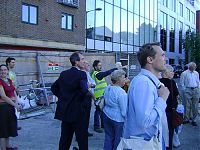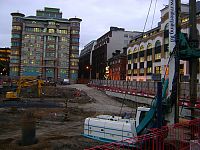Narratives, Open Evenings and Deep Maps
- By: Guy Hunt |
- Jul 28, 2008
- Share
- del.icio.us

It has been over a month since I last contributed to the Journal, so this entry is overdue. I Have been busy working on other areas of the site and also on our open evenings.
Hopefully you will have noticed that we have updated and revised our The Site section, with new period overviews to make it easier to understand the basic chronology of the site. These texts sprang out of the site tours which I have been giving to visitors as part of National Archaeology Week. On one hand it seems wrong to be giving such a simplified and single voiced narrative where I would rather have a more free form series of narratives. On the other hand the tours have really made it apparent that first time visitors need basic chronologies and information in order to begin forming their own opinions. I imagine that this tension has been discussed with far greater erudition by others, but it is really apparent how this is not something confined to a theory class. All of the articles in this website give the author’s name at the bottom, but it is very clear from visitor’s comments that they are reading our work as if it had a single voice or was a single unified narrative. On some level people expect the ‘expert voice’ and it is hard to come up with ways of avoiding this whilst still giving people a meaningful experience of the archaeology on site. The experience of National Archaeology Week was really excellent, it was so interesting to see the ways in which our work is perceived and it is great to have the opportunity to show people what we do and allow them to form new opinions.
I am writing and article at the moment for Current Archaeology which will set out some of my motivations for starting this whole digital project. The first thing it is worth remembering is that we are the first commercial project to ever attempt something so complete. It is this roundedness that makes the project appealing. Inspired by, but not really living up to ideas such as deep maps. The project is a recognition that as archaeologists we produce not just a single narrative, but a “hypertext” a mass of linked and non narrative media that have value and meaning as a whole and that this hypertext can be read in different ways by different users. The project is also a recognition of the fact that a free form mass of data alone would be confusing and seem impenetrably elitist to the casual reader. There is a recognition that we need to provide some more traditional narratives to act as jumping off points into the work we have created.
Our data is live online during the course of the excavation, this has its problems, but it also has its benefits. On the negative side, this requires a discipline (and nagging) from the excavators to make their records and to publish them quickly – further additions and revisions always being welcomed. On the benefit side, our environmental archaeology specialist is already using the data online from Cambridge. Rather naively I had also hoped that it might promote alternative narratives, but it is hard to keep pushing people to contribute and to contribute something they feel proud of publishing.
The project is very much a work in progress, but we hope that it shows the way we intend to move forward and keep creating.

